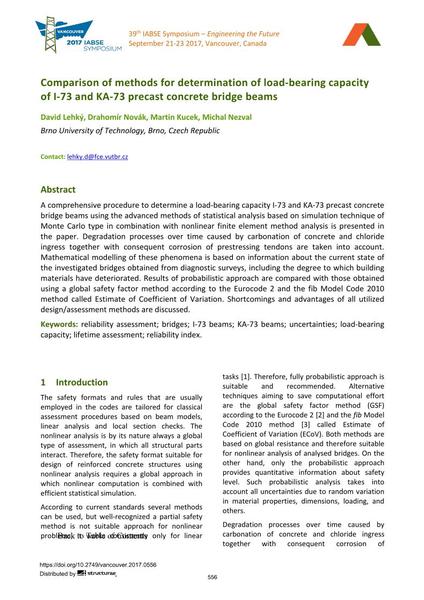Comparison of methods for determination of load-bearing capacity of I-73 and KA-73 precast concrete bridge beams

|
|
|||||||||||
Bibliografische Angaben
| Autor(en): |
David Lehký
(Brno University of Technology, Brno, Czech Republic)
Drahomír Novák (Brno University of Technology, Brno, Czech Republic) Martin Kucek (Brno University of Technology, Brno, Czech Republic) Michal Nezval (Brno University of Technology, Brno, Czech Republic) |
||||
|---|---|---|---|---|---|
| Medium: | Tagungsbeitrag | ||||
| Sprache(n): | Englisch | ||||
| Tagung: | IABSE Symposium: Engineering the Future, Vancouver, Canada, 21-23 September 2017 | ||||
| Veröffentlicht in: | IABSE Symposium Vancouver 2017 | ||||
|
|||||
| Seite(n): | 556-561 | ||||
| Anzahl der Seiten (im PDF): | 6 | ||||
| Jahr: | 2017 | ||||
| DOI: | 10.2749/vancouver.2017.0556 | ||||
| Abstrakt: |
A comprehensive procedure to determine a load-bearing capacity I-73 and KA-73 precast concrete bridge beams using the advanced methods of statistical analysis based on simulation technique of Monte Carlo type in combination with nonlinear finite element method analysis is presented in the paper. Degradation processes over time caused by carbonation of concrete and chloride ingress together with consequent corrosion of prestressing tendons are taken into account. Mathematical modelling of these phenomena is based on information about the current state of the investigated bridges obtained from diagnostic surveys, including the degree to which building materials have deteriorated. Results of probabilistic approach are compared with those obtained using a global safety factor method according to the Eurocode 2 and the fib Model Code 2010 method called Estimate of Coefficient of Variation. Shortcomings and advantages of all utilized design/assessment methods are discussed. |
||||
| Stichwörter: |
Brücken Tragvermögen Unsicherheiten Zuverlässigkeitsindex
|
||||
